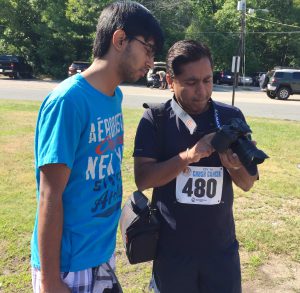Introduction
An Ordinary Runner is a short movie about an ordinary man who likes to run, his routine, and how running touches various aspects of his life. The movie is reminiscent of an Indian family living abroad. It has a tinge of humor and fun moments as observed in daily life. It conveys a simple message “Running is not just about running, it’s about living.”
The story of An Ordinary Runner
Raj is an ordinary guy living abroad. He is a runner and an Indian at heart. The movie pivots around his routine and his passion for running. From routine chores to long working hours to giving back to the community, running influences every aspect of his life. The light fun theme goes through out the movie that carries a simple message
Live every moment of your life.
Director’s Corner
You will notice the term “AOR” in my answers/comments below. That’s the short form for An Ordinary Runner.

Q. What is the inspiration behind An Ordinary Runner?
Nitin: Two main things inspired the story.
- Firstly, my journey as a runner. Going from 800m to 10K took me some time. It was not easy. But, along the way I not only developed my running skills, I started enjoying it.
- Secondly, in the past the sports movies I got to watch focused on real athletes (or drew an inspiration in some form), their challenges and accomplishments. When I thought of AOR’s script, I had an ordinary man in mind, his routine and the typical experiences many of us go through in day to day lives. In my humble opinion, what makes this story more interesting is the blend of his passion and routine; and the influence of running on various aspects of his life.
Q. Does the story convey “If I can do it, anyone can”? Or did you want to inspire others to start running?
Nitin: Well, the story does reflect a common man’s passion for running amid his routine. So, yes, for people who are on the cusp of thinking whether to run or to give up, I do want to suggest to give it a fair shot, if they can. Do not give up too early. But, I also wanted to present the dimension of running that may not be always apparent. Things like running is also a way to give back to the community, building rhythm and stamina, and developing a habit of taking things to the finish line; running simply goes beyond just staying fit.
Q. What were some of the challenges you experienced while shooting for An Ordinary Runner? How did you handle those?
Nitin: AOR was an interesting learning experience.
- Majority of the shoot for An Ordinary Runner was done in late evenings or weekends. Again, amid routine, coordination and time management was tricky. The good part was, I had already planned out the critical scenes in advance and the storyline was always in my mind. So, with little bit of planning, I was able to optimize our shoot sequences to get the maximum footage recorded.
- When you shoot in public places, you want to be respectful of privacy of the people around. Hence, some of the sequences in public places took longer to shoot. Time and patience were the key.
- Majority of the shoot was done using a handheld camera. Many a times we could not even use a tripod. So, during editing I tried my best to smoothen out things like camera shakes.
Q. You mention this is your first movie. What will be your advice to aspiring filmmakers?
Nitin: Honestly, I don’t think I’m in a position to advise others. However, I can share my experiences and suggest a few recommendations.
- There is no substitute for good planning. Of course, use your judgement. But, plan out things in as advance as possible.
- Just having a good story idea is not enough. If you want it to turn out equally beautiful in production, go that extra mile to hash out your script more thoroughly. One thing that I found very helpful for my movie is identifying the key scenes in advance. These helped me improve my script as well as optimize my shoot, such as, combining shooting for a few clips that were not necessarily in a sequence in the movie.
- You must know the features of equipment you are using. Especially, when you are out on field all by yourself, you do not have room for experimentation. I highly recommend spending time before the actual shoot on playing around with the equipment, learning important settings, etc. I spent some decent time trying out various settings to handle light, getting the depth of field effect, etc.
- It is worth mastering the movie editing software you are planning to use, especially if you are an indie filmmaker. Again, knowing what it is capable of can help you big time in post-production from things like fixing shooting mistakes to enhancements to special effects.
- One thing as a filmmaker you do not want to underestimate is the sound quality. Simple things like hum and static that we are used to listening in typical home videos simply become annoying to movie audience. Pay extra attention to the quality of sound. If needed, use audio editing software to make correctiosn and enhancements.
Q. What equipment did you use?
Note: We get a small commission if you purchase by clicking on the product links below.
- For shooting and most of audio recording I used the Panasonic Lumix GH4 4K Camera with Panasonic 14-140mm lens.
- For movie editing, I used Apple’s Final Cut Pro X.
- For audio editing, I used the open source Audacity software.
Q. What message would you like to give to your viewers?
I believe movies are expressions of our world. So, keep enjoying movies and go cherish your dreams.
